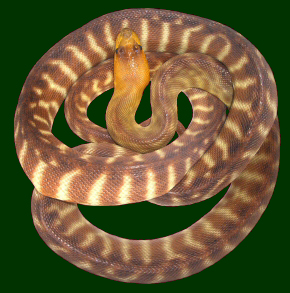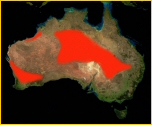

Description
 Womas typically have a pale brown or beige base color, accented by darker brown irregular banding. The head is generally more intensely colored than the rest of the body, particularly in young animals. Most womas, particularly when young display the characteristic dark eye spots over the eyes which are among this taxons more distinctive features.
Womas typically have a pale brown or beige base color, accented by darker brown irregular banding. The head is generally more intensely colored than the rest of the body, particularly in young animals. Most womas, particularly when young display the characteristic dark eye spots over the eyes which are among this taxons more distinctive features.This is a medium sized python with adults averaging 4-6ft in length. The largest womas are South Australian specimens, which can achieve lengths of 8ft.
Womas exhibit many morphological characteristics consistent with their arid sandy environment. The two most obvious traits that set both species of the genus Aspidites apart from all other pythons are their head structure and their lack of visible thermoreceptive pits. The head structure is modified in much the same way as is seen in many fossorial species, with the rostoral area tapering to a sharp leading edge. It’s a logical adaptation considering this species primary habitat of red sand desert. The second unique characteristic of this genus its lack of heat pits, has been the subject of much study and debate. The conventional belief for years was that Aspidites was the most primitive of the python genera based on their lack of thermoreceptive pits. It now
 seems unlikely that Aspidites lack heat pits because they are a more primitive lineage, rather it seems more likely that they have simply lost most traces of their thermoreceptors. The habitat and lifestyle of both Aspidites species reduce the need for these features and could make them problematic as they become clogged with fine red desert sand. Both species of Aspidites feed on a much higher percentage of reptiles in their diet than is typical for most python taxa. This increased amount of cold blooded prey further negates the need for thermoreceptors. Some recent research suggests that though there may be no external signs of thermoreceptors, these animals may still posses a limited heat sensing ability.
seems unlikely that Aspidites lack heat pits because they are a more primitive lineage, rather it seems more likely that they have simply lost most traces of their thermoreceptors. The habitat and lifestyle of both Aspidites species reduce the need for these features and could make them problematic as they become clogged with fine red desert sand. Both species of Aspidites feed on a much higher percentage of reptiles in their diet than is typical for most python taxa. This increased amount of cold blooded prey further negates the need for thermoreceptors. Some recent research suggests that though there may be no external signs of thermoreceptors, these animals may still posses a limited heat sensing ability.
Habitat
_thm.jpg) This species prefers the arid regions within its range. Womas are usually associated with areas of sand and spinifex but can also be found in grassland and in more rocky areas. This is an extreme environment with huge variation in temperature from day to night.
This species prefers the arid regions within its range. Womas are usually associated with areas of sand and spinifex but can also be found in grassland and in more rocky areas. This is an extreme environment with huge variation in temperature from day to night.
Distribution
 Womas have a large distribution in the Australian interior, occurring in the interior portions of New South Wales, Queensland, Northern Territory, South Australia and Western Australia. There are two other possibly disjunct populations of Aspidites ramsayi. In Western Australia there is a population along the coastal portions of the Pilbara and the Kimberley. The second possibly disjunct population is that of the rare southwestern woma. The southwestern population extends from the coastal areas of the southern third of Western Australia, eastward to the Nullarbor Plain. There is debate as to whether these two populations are in fact isolated or if gene flow occurs between these three areas.
Womas have a large distribution in the Australian interior, occurring in the interior portions of New South Wales, Queensland, Northern Territory, South Australia and Western Australia. There are two other possibly disjunct populations of Aspidites ramsayi. In Western Australia there is a population along the coastal portions of the Pilbara and the Kimberley. The second possibly disjunct population is that of the rare southwestern woma. The southwestern population extends from the coastal areas of the southern third of Western Australia, eastward to the Nullarbor Plain. There is debate as to whether these two populations are in fact isolated or if gene flow occurs between these three areas.
Projects
I am currently working with 2.2
